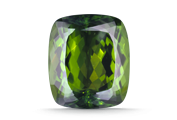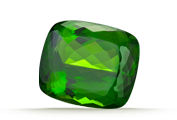Peridot Found in lava, meteorites, and deep in the earth’s mantle, yellow-green peridot is the extreme gem Peridot (/ˈpɛrɪdɒt/ or /ˈpɛrɪdoʊ/) (sometimes called chrysolite) is gem-quality olivine and a silicate mineral with the formula of (Mg, Fe)2SiO4. As peridot is a magnesium-rich variety of olivine (forsterite), the formula approaches Mg2SiO4.
ABOUT PERIDOT
The ancient Egyptians mined peridot on the Red Sea island of Zabargad, the source for many large fine peridots in the world’s museums. The Egyptians called it the “gem of the sun.” Today this gem is still prized for its restful yellowish green hues and long history. Large strongly-colored, examples can be spectacular, and attractive smaller gems are available for jewelry at all price points.
BIRTHSTONES & ANNIVERSARIES
Peridot is the birthstone for August and the 15th anniversary gemstone.
4.5 BILLION
Some peridot is ancient: it’s found in pallasite meteorites, remnants of our solar system’s birth.
STARDUST
In 2005, peridot was found in comet dust brought back from the
Stardust robotic space probe.
OLIVINE
Gem variety of the mineral olivine: found in peridotite rock from the
earth’s upper mantle.
FACTS
- Mineral: Olivine
- Chemistry: (MgFe)2SiO4
- Color: Yellowish green
- Refractive index: 1.65 to 1.69
- Birefringence: 0.035 to 0.038
- Specific gravity: 3.34
- Mohs Hardness: 6.5 to 7
QUALITY FACTORS
Beautiful, yellowish green peridot has been treasured since earliest times.
COLOR

Although the best peridot is a pure grass green, most is yellowish-green.
CLARITY

Most fine peridot is eye clean. Tiny black spots might be visible with magnification.
CUT

Peridot is cut in a wide variety of styles, including ovals, emerald cuts, and cushions.
CARAT WEIGHT

Large crystals of peridot have cut gems more than 50 carats in size.

